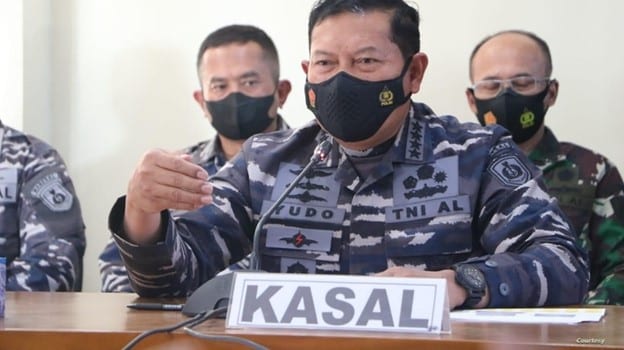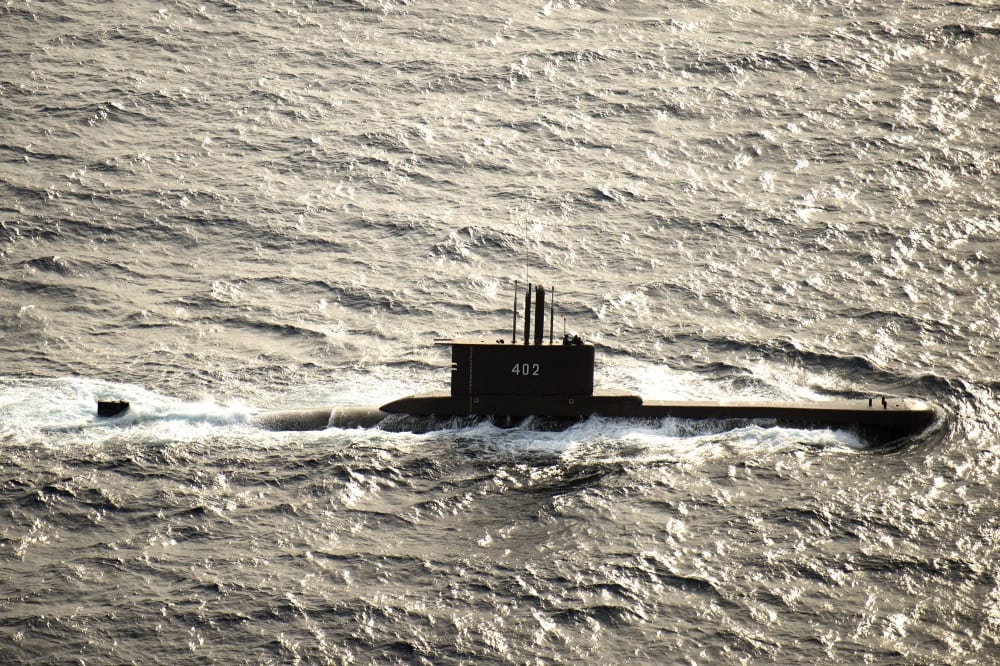
The Indonesian navy has changed that status of its submarine, KRI Nanggala (402), and her crew of 53, from “sub miss” to “sub sunk.”
Indonesian authorities said the damaged submarine has been located.
“The KRI Nanggala is divided into three parts, the hull of the ship, the stern of the ship, and the main parts are all separated, with the main part found cracked,” said Indonesian navy Chief of Staff Yudo Margono.
“We received underwater pictures that are confirmed as the parts of the submarine, including its rear vertical rudder, anchors, outer pressure body, embossed dive rudder and other ship parts,” said military chief Hadi Tjahjanto, speaking to the media in Bali on Sunday.
KRI Nanggala went missing during a torpedo firing exercise on Wednesday in waters between Bali and Java, Indonesia. A massive search effort was conducted by the navy, known officially as the Tentara Nasional Indonesia-Angkatan Laut (TNI-AL). Other nations, including the U.S., dispatched ships, aircraft, personnel to help in the search and rescue of the crew.
Aircraft searching the area noted an oil slick was which was suspected to have come from the submarine. “That oil spill location is the last time we had contact with the submarine,” Indonesian navy spokesman First Adm. Julius Widjojono said.
In addition to the oil slick, confirming the likelihood that the submarine broke apart was the retrieval of several items that were shown to journalists. A container of grease used for periscopes, part of a torpedo launcher, part of a metal tube, prayer mats and fuel were recovered were about two miles from the where the submarine commenced its dive before it went missing. Later a life vest from the sub was found. The water at the location where the floating debris was found is 2,788 feet.
There were no reports of loud underwater noises that would point to an explosion, but Margono said the heavy pressure on the vessel probably caused the hull to lose integrity, permitting some items to escape and rise to the surface.
“With the authentic evidence we found believed to be from the submarine, we have now moved from the ‘sub miss’ phase to ‘sub sunk,’” Margono said at a press conference.
Margono later said sonar detected a submarine-like object at 850 meters (2,790 feet), far below the Nanggala’s safe operating depth.
“It can be stated that the KRI Nanggala has sunk and all of its crew have died,” military chief Marshal Hadi Tjahjanto told reporters.

Although initial reports stated the submarine was last reported at a location north of Bali, a later statement from the Indonesian Ministry of Defense said the sub was lost in the Bali Strait, between the islands of Java and Bali that connects to the Indian Ocean to the south and Bali Sea to the north.
The search effort was coordinated from the naval base at Banyuwangi, on the eastern tip of Java, the most populated of Indonesia’s 17,000 islands.
Earlier in the search effort, an Indonesian ship, KRI Rimau, detected a very strong magnetic signature, in an area consistent with the submarine’s last known position, later confirmed by survey ship, KRI Riguel.
Before the submarine was confirmed sunk, a number of nations sent help or offered to support the search effort. Singapore, Malaysia and India dispatched submarine rescue ships and two Australian warships sailed to join the search efforts.
“HMA Ships Ballarat and Sirius, both presently at sea on separate regional deployments, are making best speed for the search area,” said a Friday press release from Australia’s defense department.
Rear Adm. Mark Hammond, of the Australian task force, added that his thoughts were with the submariners of KRI Nanggala, their families and the Indonesian people. “As always, we stand ready to assist our fellow mariners in the Indonesian navy,” he said.
The U.S. Navy sent a P-8 Poseidon maritime patrol aircraft to support the effort.
“It’s a sophisticated platform that could be helpful in leading the Indonesian government to a better idea of the location,” said Pentagon spokesman John Kirby.
Secretary of Defense Lloyd J. Austin III spoke with Indonesian Defense Minister Prabowo Subianto to inform him that the aircraft was coming and provide any additional assistance that might be needed, Kirby told reporters.
In addition to the P-8, the U.S. sent three C-17 aircraft carrying boats and underwater search and rescue equipment from Dover Air Base on Friday.
Indonesian President Joko “Jokowi” Widodo directed that the search and rescue efforts for Nanggala and crew was a national priority. “To the families of the crew, I understand your feeling right now. However, the government has done and will continue to do its utmost to search and rescue all crew on board,” he said while the search was underway.
“I am deeply saddened to learn the Indonesian submarine lost at sea earlier this week is now believed sunk. Our thoughts and prayers are with the Indonesian navy, their Sailors and all those families who lost loved ones,” said Chief of Naval Operations, Adm. Mike Gilday. “As Sailors, we share a love for the sea and have a bond of fellowship with all who sail on it. We have a respect for its dangers and also understand the importance of the worlds’ oceans to our collective way of life.
“No doubt, Indonesia is a good friend and partner. Despite this tragic loss, it is my hope that we will continue to operate together in support of a free and open Indo-Pacific,” Gilday said.
The mission now changes from rescue to recovery.
- A Day to Remember - September 11, 2023
- Indo-Pacific Maritime Security Exchange will examine emerging capabilities and capacity - July 12, 2023
- Cold Waters Spark Warm Relationship - April 20, 2023






